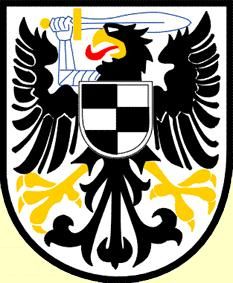Posen-Westpreussen: Difference between revisions
Jump to navigation
Jump to search
Knorrepoes (talk | contribs) m (Text replacement - "{{de}}" to "") |
Knorrepoes (talk | contribs) m (Text replacement - "{| class="wikitable"↵|+Official blazon↵|-↵|'''German'''↵| ↵|-↵|'''English''' ↵| {{blazon wanted}}↵|}" to "{| class="wikitable" |+Official blazon |- |'''German''' | blazon wanted |- |'''English''' | blazon wanted |}") |
||
| Line 9: | Line 9: | ||
|- | |- | ||
|'''German''' | |'''German''' | ||
| | | blazon wanted | ||
|- | |- | ||
|'''English''' | |'''English''' | ||
| | | blazon wanted | ||
|} | |} | ||
Revision as of 07:36, 6 April 2023
POSEN-WESTPREUSSEN
| German | blazon wanted |
| English | blazon wanted |
Origin/meaning
After the Versailles treaty in 1919, a large part of the Prussian provinces Posen and Westpreussen were transferred to the new Polish republic. The remaining area was transformed into a bufferzone, or Grenzmark named Posen-Westpreussen.
The arms were from 1925-1929 identical to the arms of Westpreussen, without the supporters and helmet. In 1929 the Polish eagle was replaced by a small shield showing the colours of the flags of Westpreussen (black-white-black) and Posen (white-black-white).
In 1938 the Grenzmark ceased to exist.
Literature : Schurdel, H.D. Flaggen und Wappen Deutschland. Battenberg, Augsburg 1995.
